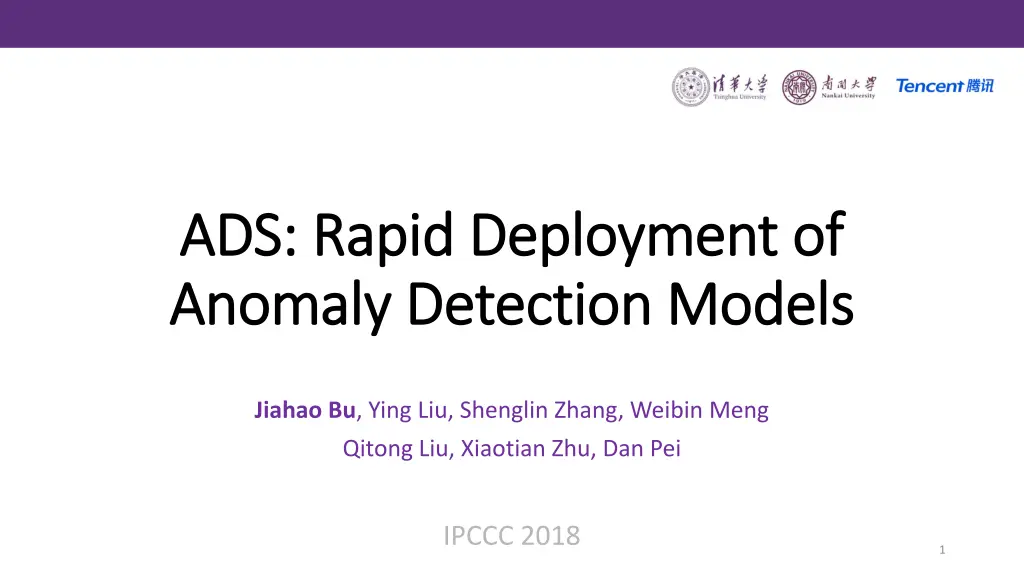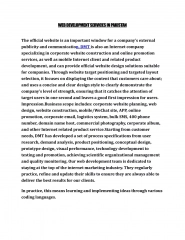
Rapid Deployment of Anomaly Detection Models
Explore the rapid deployment of anomaly detection models in the context of server performance monitoring and response to internet failures. The study covers background information, problem definition, design strategies, evaluation methods, and insightful conclusions based on real-world scenarios. Stay updated with the latest techniques for efficient anomaly detection.
Uploaded on | 0 Views
Download Presentation

Please find below an Image/Link to download the presentation.
The content on the website is provided AS IS for your information and personal use only. It may not be sold, licensed, or shared on other websites without obtaining consent from the author. If you encounter any issues during the download, it is possible that the publisher has removed the file from their server.
You are allowed to download the files provided on this website for personal or commercial use, subject to the condition that they are used lawfully. All files are the property of their respective owners.
The content on the website is provided AS IS for your information and personal use only. It may not be sold, licensed, or shared on other websites without obtaining consent from the author.
E N D
Presentation Transcript
ADS: ADS: Rapid Deployment of Rapid Deployment of Anomaly Detection Models Anomaly Detection Models Jiahao Bu, Ying Liu, Shenglin Zhang, Weibin Meng Qitong Liu, Xiaotian Zhu, Dan Pei IPCCC 2018 1
Outline Outline Background Problem definition Design Evaluation Conclusion 2
Outline Outline Background Problem definition Design Evaluation Conclusion 3
Background Background Servers Processes Key Performance Indicators e.g. , CPU Utilization Search Response Time 4
Background Background However, the anomalies on KPI likely indicate underlying failures on Internet services E.g., a spike or dip in a KPI stream 5
Background Background Alarm! TSD Anomaly Detector Detection boundary [Sigcomm13] Mon. Tue. Wed. Time 6
Background Background Anomaly Select / combine detectors Moving Average Anomaly Detector Holt-Winters Time Series Decomposition [IMC15,KDD15] Operator Tune parameters & thresholds Mon. Tue. Wed. Time 7
Background Background However, there remains one common and important scenario that large number of KPI streams emerge continuously and frequently, which has not been studied !!!! 8
Background Background Case 1: Case 2: #1 #1 6000 new KPI streams per 10 days on average. Software upgrades become more and more frequent New games are launched Software upgrades [ISSRE15,CoNext15] 9
Outline Outline Background Problem definition Design Evaluation Conclusion 10
Problem Problem definition definition Why it's challenging? Select / combine detectors Anomaly Moving Average False Alarm Holt-Winters Time Series Decomposition Missing Alarm Tune parameters & thresholds New anomaly labeling Lack of training data 11
Problem Problem definition definition Why it's challenging? Select / combine detectors Anomaly False Alarm Moving Average Holt-Winters Time Series Decomposition Missing Alarm New anomaly labeling Lack of training data Tune parameters & thresholds Traditional statistical algorithms 12
Problem Problem definition definition Why it's challenging? Anomaly Select / combine detectors Moving Average False Alarm Holt-Winters Time Series Decomposition Missing Alarm Tune parameters & thresholds Lack of training data New anomaly labeling Supervised learning based methods [IMC15,KDD15] 13
Problem Problem definition definition Why it's challenging? Select / combine detectors Anomaly False Alarm Moving Average Holt-Winters Time Series Decomposition Missing Alarm Tune parameters & thresholds New anomaly labeling Lack of training data [ICDM08,WWW18] 14
Outline Outline Background Problem definition Design Evaluation Conclusion 15
Design Design 16
Design Design 17
Preprocessing Preprocessing Fill these missing points using linear interpolation Standardization 18
Design Design 19
Clusering Clusering ADS adopts ROCKA to group KPI streams into a few clusters. Then we obtain a centroid KPI stream for each cluster and can label anomaly points. [IWQoS 18] 20
Design Design 21
Feature Feature extraction extraction Detector: Feature extractor Feature: Measure how anomalous that data point is. Feature vector: All feature values extracted by specific detectors. 22
Design Design 23
Semi Semi- -Supervised Learning Supervised Learning In this work, we adopt contrastive pessimistic likelihood estimation (CPLE) , an extension model of self-training. CPLE has the four following advantages: CPLE is flexible to change base-model CPLE needs low memory complexity CPLE is more robust than other semi-supervised learning algorithms CPLE supports incremental learning. [TPAMI15] 24
Semi Semi- -Supervised Learning Supervised Learning In addition, the negative log loss for binary classifiers takes on the general form: where N is the number of the data points in the KPI streams of training set, yiis the label of the i-th data point and piis the i- th discriminative likelihood (DL) 25
Semi Semi- -Supervised Learning Supervised Learning The objective of CPLE is to minimize the function: where X is the data set of labeled data points, U is the unlabeled data points, and y = H(q), where: This way, (the parameter vector of) the base-model, which serves as the anomaly detection model, is trained based on (X U U) using actual and hypothesized labels (y U y ), as well as the weights of data points w, where: 26
Outline Outline Background Problem definition Design Evaluation Conclusion 27
Data Set Data Set The following table is description of 81 new ones : 28
Evaluation of The Overall Performance Evaluation of The Overall Performance To evaluate the performance of ADS in anomaly detection for KPI streams, we calculate its best F-score, and compare it with that of iForest, Donut and Opprentice. The picture is the CDFs of the best F-scores of each new KPI stream 29
Evaluation of CPLE Evaluation of CPLE ROCKA + Opprentice: we train Opprentice using the features and manual labels of its centroid KPI streams. After that, we detect anomalies for the each new KPI stream using the Opprentice model trained based on this new KPI stream s cluster centroid. The following table is new KPI streams where ADS performs significantly better than ROCKA + Opprentice. 30
Evaluation of CPLE Evaluation of CPLE The anomaly detection results of ROCKA + Opprentice on KPI stream , and s cluster centroid KPI stream. The red data points are anomalous determined by ROCKA + Opprentice while in actual they are normal. 31
Evaluation of CPLE Evaluation of CPLE ADS addresses the above problem effectively using semi-supervised learning. In other words, it learns not only from the labels of the centroid KPI stream, but also from the fluctuation degree of the new KPI stream. 32
Outline Outline Background Problem definition Design Evaluation Conclusion 33
Conclusion Conclusion ADS is the first to identify the common and important problem of rapid deployment of anomaly detection models for large number of emerging KPI streams ADS is the first to apply semi-supervised learning on this field ADS achieves an averaged best F-score of 0.92 on 81 new KPI streams, almost the same as the state-of-art supervised approach 34
Thank you ADS IPCCC 2018 bjh16@mails.tsinghua.edu.cn 35






















